Haroon Mirza
Stone Circle and The Wave Epoch
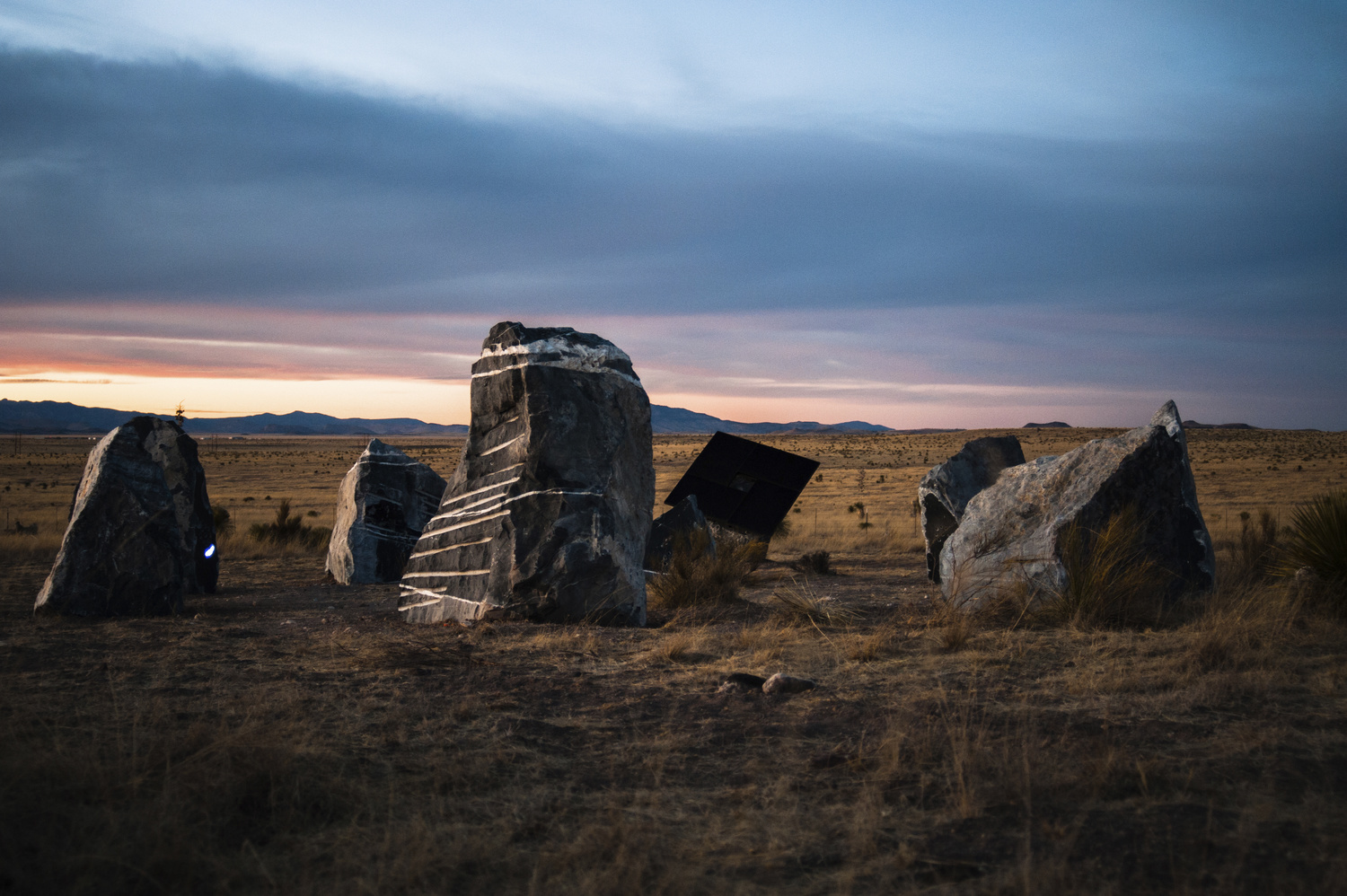
Haroon Mirza, Stone Circle, 2018. 9 stones, LEDs, speakers, solar panels. Dimensions variable. Photographer Emma Rogers.
…going down the river in the darkness, and the ayahuasca session is amping up and you just have no idea what’s going on in there, and, you know, you’re just in the darkness. Everybody off to the side starts singing, and they’re singing in their own harmonic overtone sounds. The songs are kind of random and they kind of all match, but they don’t match. The tuning is all off. I remember that just feeling the multiplicity of the universe, the harmony of the dimensions in the space that I was in. That was very tangible; there was also death, there was also birth…
You come to inside a basement tunnel somewhere in western Switzerland. Whoever was here before left in a hurry: tangles of cables, torn-up notebooks, and globs of rusted hardware spill out of moldy cardboard boxes scattered around the concrete chamber. Following the tunnel leads you into a cathedral-like clearing; at the center sits two halves of some gigantic metal cylinder that’s emitting a low hum. A wall of ancient computer monitors nearby indicates this architectural folly is some sort of particle collider, ostensibly for scientific research. But a scattering of half-drunken beakers of ayahuasca tea suggests otherwise. This has to be some kind of ritual site.
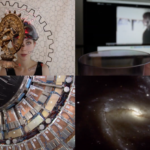
Still from The Wave Epoch, 2020. Haroon Mirza & Jack Jelfs ft. Gaika at CERN, Switzerland.
At times it can sound like dissonant disharmonic (chuckles) crazy loops, if you’re really aware of the chaotic state of the world and all the weird stuff that’s happening. I’m quite a schizophrenic person, I think I have, like, two brains or something, not to mention I’m bipolar (chuckles) so it’s totally different, you know, the different states of my mind and the different wavelengths and frequencies and all that..
When Haroon Mirza and Jack Jelfs first showed up at CERN, the European Organisation for Nuclear Research, it felt like they had stumbled upon a future ruin. The more time they spent in the subterranean labs of the Swiss research institute, the more it felt like an archaeological site caught between worlds. CERN’s famed Large Hadron Collider – the most powerful particle collider currently in operation, over 16 miles long, constructed in a gigantic cosmic ring 100 meters beneath borderland soil – had failed to answer to the euphoric techno-optimism of its inception, financed by a 1990s global drive to answer the biggest questions of our universe. Imagining the collider was abandoned and rediscovered 2,000 years down the line by some other civilization, Mirza and Jelfs wondered, would they think of it as a scientific experiment or a ritualistic space? Maybe the two are less diametric opposites than foils – two methods of cosmological thought?
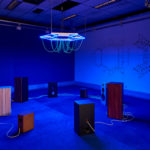
Haroon Mirza, Lectures in Theology, 2020. 24-channel electrical signal, Stainless steel, hi-fi speakers, carpet, LED tape, wall painting. Photo by Randhir Singh.
Working predominantly through electricity, Mirza explores the connections between science and ritual, language and cognition, nature and mathematics, the origins of the universe and the origins of consciousness, and the belief systems that materialized alongside it. The Wave Epoch (2020) emerged out of Jelf and Mirza’s time at CERN, as a music album and accompanying video that deconstructs the relationship of language and matter, ritual and belief systems and scientific method. Convening with physicists at CERN – each with their own set of rigid cosmological ideologies – they attempted to burrow beneath the skin of mathematical order and empirical logic, coaxing these voices beyond the precipice of certainty. The 7-track, 34-minute-long album weaves together music, AI poetry, incantation, interviews, found and original footage and homemade electronic instruments from technological flotsam salvaged at CERN.
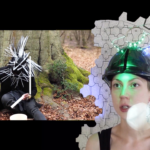
Still from The Wave Epoch, 2020. Haroon Mirza & Jack Jelfs ft. Gaika at CERN, Switzerland.
Track 4, titled one1one, is a psychedelic mash-up of data that destabilizes dominant structures of scientific logic, language, and consciousness. “We’re ordered to tackle sounds: here is the 25th God here,” decrees the AI poet-prophet trained by Jelfs, a set of glowing LEDs running parallel to its staticky beat. Post-internet graphics melt into postmodern suburban utopias melt into sports cars and antiquated GPS satellites while the AI’s decrees grow increasingly more abstracted. Hazy renderings of particles float alongside a cosmic satellite; businessmen step in sheep shit in a bucolic English countryside. London-based musician Gaika makes a cameo, clambering around what looks like a ruined chunk of particle collider and activating forested sound bowls. There’s science labs, there’s Classical Grecian columns, there’s a scientist on a trip with a split personality – homelover and wanderlust (the latter wins, as she astral projects into a CGI cosmos). As the track progresses, it begins to break down; the AI’s mantra becomes fully nonsensical, replicating the ultimate struggle of language.
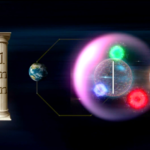
Still from The Wave Epoch, 2020. Haroon Mirza & Jack Jelfs ft. Gaika at CERN, Switzerland.
“On the one hand, the technology of language galvanized humans and helped us get shit done,” suggests Mirza. “As soon as you define things with sonic representations, you can communicate that thing without seeing it or hearing it. But on the other hand, it’s so limiting. There’s this otherness you want to engage with and can’t communicate with language, so you have to do it by other means. I remember once drinking ayahuasca and saying in Urdu, my mother tongue, ‘یہ صرف ایک زبان ہے,’ which means, ‘this is just a language’. As if it’s kind of like, making these sounds to form language became such a futile thing.”
“The whole purpose of psychedelics is, in a way, to sort of sometimes bypass language to get to a deeper connectivity with yourself and the outside world.
After my EGO WASTE tour, I visited a remote location right on the border of Iran, Pakistan and India. No one lives on that land, it’s all military land, and it’s not safe to enter there. But it’s absolutely beautiful; I love all the mountains and trees and that kind of stuff. A lot of really special things happened there, but the thing that really stuck with me was, in the local dialects there’s this word—It’s pronounced “oosh” with a long O sound—it means “aware,” “conscious.” But in the Dari and Pashtun dialects it means “the space in which energy moves in all directions.” I thought, Oh, that’s an interesting translation. I thought it was interesting because it was really synching up with the way I felt there. I could just move there because of the energy.
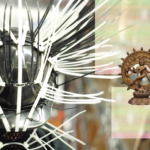
Still from The Wave Epoch, 2020. Haroon Mirza & Jack Jelfs ft. Gaika at CERN, Switzerland.
You step into the ruins of the collider, and the sound waves it’s emitting begin to bottom out at a low hum. The sound has entered your body somewhere, a slight vibration of molecules splits muscle from bone, traveling up your throat, settling between your teeth, leaving a metallic taste on your tongue. “When I say beauty, I guess I mean structure,” the ghost of a scientist stutters to life over an image of CERN’s rusted ventilator systems. “Power distribution requires knowledge,” counters a disembodied AI oracle from deeper within the collider. “Keep uninstalling if possible. There are compelling reasons to reason with logical reasonableness.”
Music sounds like a bell curve; consciousness is more like a square wave, a binary code. Music is like a process; consciousness is like a singularity, like a kind of loop.
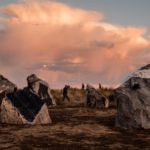
"Stone Circle", Haroon Mirza, 2018. 9 stones, LEDs, speakers, solar panels. Dimensions variable. Photo by Rowdy Lee Dugan.
In the middle of a west Texan high desert there is a single-road town where leathery cowboys and liberal arts grads do business, a flattened prairie of near-infinite expanse, an inverted basin full of stars. Out in a field owned by some ranching family slash art collector is a circle of black marble boulders, roughly hewn, monolithic in stature, transported from Mexico in a Trump-era United States after a year in custody: a miraculous defiance of both physics and geopolitics. The Mother stone – identifiable by a large solar panel grid strapped to her back – slowly gathers the latent solar energy of a lunar cycle. Every full moon, she lets it all go: electricity passes through the stones’ mycelial network of underground cables; the stones begin to light up and emit short bursts of sound, slowly and quietly at first, retraining themselves, re-entering language, building up to a structured electric pattern that lasts 36 minutes.
The day that Mirza unveiled Stone Circle (2018), a freak electrical storm complete with hail rolled through the desert, no warning. When the sun set, the stones wouldn’t run their sequence, despite working after the storm. “To this day we have no idea why,” shares Mirza. “We had an electrical engineer take a look and he said there was no explanation for it not working. It was like the stones were protesting.”
Tripping teaches you to look behind the curtain, so I guess if you’re hanging out with people who are using these substances, you’re definitely more open to doing the same. I was tripping with a bunch of people in LA a couple of weeks ago. There was this guy named Michael, who owns a public relations firm for big celebrities in LA. He has a ton of young clients, but he was talking about how LA is absolutely insufferable, especially being a middle-aged man. He said he used to be a basic bro, but all the money and fame has just made him so miserable. He was like, I need to smoke weed and hang out with the kids, and receive their energy, because everyone in my employment is younger than me so I get the magic of youth.
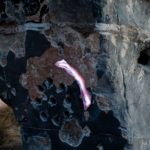
"Stone Circle", Haroon Mirza, 2018. 9 stones, LEDs, speakers, solar panels. Dimensions variable. Photographer Emma Rogers.
There is a theory that the emergence of human consciousness – which goes hand in hand with the development of language, projective imagination, and production of tools – was catalyzed by proto-humans’ exposure to psychoactive mushrooms. First proposed in the 1990s, this theory has resurfaced in recent years with new insights into the precise location of brain activities that indicate consciousness. The discovery of poppy seeds in Neolithic teeth, ancient charred cannabis seeds, and drawings of hallucinogenic mushrooms in the Italian Alps suggest that tripping may have been a part of proto-human activities before the rapid brain expansion of the Homo Sapien era; but there is no question that psychedelics does alter consciousness and triggers physical changes in the brain. Activity evacuates the prefrontal cortex, which is linked to a sense of self – causing the “ego death” experience of tripping – while there is a surge in the primitive brain network, which constitutes emotional reactions and memory. Exposure to 111 hz produces a similar effect.
Then, there was this spiritual healer, Aaron, who started Goop, Gwyneth Paltrow’s lifestyle brand. He would not drink ayahuasca, because he said he’s a businessman in the consumer world – he makes no money, but he makes a ton of soul, as he was saying. Then I was hanging out with an astrophysicist. He was like the calmest, most attentive person. He was really observant, and he was drinking ayahuasca to boost his cosmic consciousness.
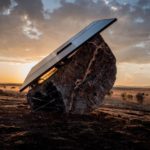
"Stone Circle", Haroon Mirza, 2018. 9 stones, LEDs, speakers, solar panels. Dimensions variable. Photo by Rowdy Lee Dugan.
“Right before the opening of Stone Circle, before the sun set and the moon started rising, this woman came up to me at the opening and she thanked me for opening up the land, as it was private ranch land owned by one of the Directors of Ballroom Marfa. She was from an indigenous tribe of the region, and said it was really important for her people to be on this land, her ancestors’ land, and she asked me if I knew what she used the land for and I was like, no, tell me. She said time travel. At that point, I was like, ‘I don’t know if you’re crazy, or if you’re telling me some esoteric truth.”
But ultimately all this stuff is just a tool. Ultimately, we’re all patterns. We’re here to form patterns using this energy, and then give it back. It’s very similar to the Hindu philosophy of Brahman and Atman. Brahman is this universal energy, and Atman is consciousness. On their own, they’re kind of like “ether,” you know, but we’re able to form patterns on top of it, and then the Atman kind of exists as a pattern on the Brahman (chuckles). It’s meant to be really simple.
The Wave Epoch, 2020, Haroon Mirza & Jack Jelfs feat. GAIKA @ CERN










